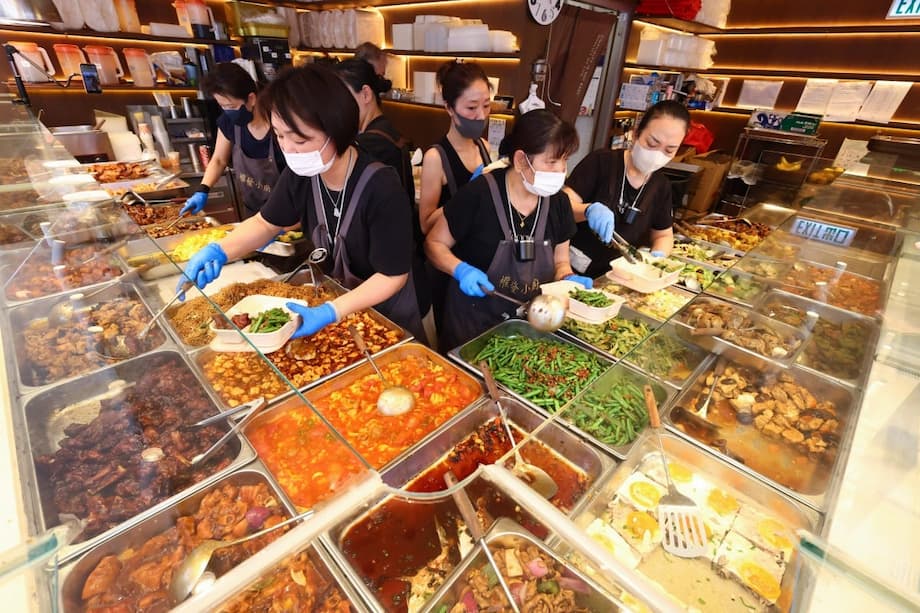Hong Kong’s Restaurant Industry Faces a Survival Crisis
Hong Kong, once renowned for its vibrant culinary scene and bustling eateries, is now witnessing an unprecedented wave of restaurant closures. As economic uncertainty grips the city, both iconic establishments and neighborhood favorites are shuttering their doors, leaving industry insiders and residents questioning the future of dining in Asia’s World City. The causes are complex, ranging from shifting consumer habits and cross-border spending to high rents and the lingering effects of the COVID-19 pandemic. This article explores the factors behind the closures, the impact on workers and the economy, and what the future might hold for Hong Kong’s food and beverage sector.
- Hong Kong’s Restaurant Industry Faces a Survival Crisis
- Why Are So Many Restaurants Closing?
- Cross-Border Spending: The Shenzhen Effect
- Changing Consumer Behavior and the Rise of Affordable Eateries
- The Human Cost: Workers and Communities Affected
- Comparisons with Mainland China: A Regional Perspective
- Government and Industry Responses: Can the Trend Be Reversed?
- In Summary
Why Are So Many Restaurants Closing?
The scale of the crisis is stark. According to Hong Kong’s Food and Environmental Hygiene Department, the city had 17,154 restaurant licenses as of April 2025—255 fewer than a year earlier. In the past year alone, 2,034 restaurants closed while only 1,779 new ones opened, signaling a net contraction in the industry. The closures are not limited to small, independent eateries; even long-standing chains and high-profile restaurants have been forced to exit the market.
Several key factors are driving this trend:
- Economic Downturn: Hong Kong’s economy has struggled to regain momentum after the pandemic. Retail sales shrank for 14 consecutive months before a modest rebound in mid-2025. The city’s jobless rate remains at a 30-month high of 3.5%, dampening consumer confidence and spending.
- Changing Consumer Habits: Locals are increasingly traveling to nearby mainland cities like Shenzhen for cheaper dining and shopping, drawn by lower prices and a wider range of options. This cross-border spending has siphoned off a significant portion of Hong Kong’s traditional customer base.
- High Rents and Operating Costs: Despite falling street rents—now at levels last seen in 2003—many landlords remain reluctant to lower prices enough to make restaurant operations sustainable. High fixed costs, including rent and wages, have squeezed profit margins to the breaking point.
- Pandemic Aftershocks: The COVID-19 pandemic fundamentally altered dining habits. Even after restrictions eased, many residents became accustomed to eating at home or seeking new experiences elsewhere, making it difficult for local restaurants to recover lost business.
Case Study: The Fall of Iconic Chains
The closure of well-known chains such as Ocean Empire Congee and King Parrot Group has sent shockwaves through the industry. Ocean Empire, a 33-year-old congee chain, and King Parrot, which once operated over 30 themed restaurants, both cited insurmountable financial pressures and changing consumer behavior as reasons for their demise. Staff from these groups have sought help from labor authorities to recover unpaid wages and entitlements, highlighting the human cost of the industry’s turmoil.
Labour sector lawmaker Aron Kwok Wai-keung commented, “Business owners facing hardship should plan ahead if they are at risk of closure to ensure employees receive their wages.”
These closures are emblematic of a broader trend: even established brands with loyal followings are not immune to the city’s economic headwinds.
Cross-Border Spending: The Shenzhen Effect
One of the most significant shifts impacting Hong Kong’s restaurant industry is the surge in cross-border spending. Since the reopening of borders and relaxation of COVID-19 restrictions, millions of Hong Kong residents have flocked to Shenzhen and other mainland cities for shopping, dining, and entertainment. Immigration data shows a 48% year-over-year increase in border crossings, with over 93 million trips in 2024 alone.
Why are so many Hongkongers heading north? Surveys and anecdotal evidence point to several reasons:
- Lower Prices: The cost of living in Shenzhen is estimated to be about 50% lower than in Hong Kong. Everyday items, from coffee to restaurant meals, are significantly cheaper.
- Variety and Experience: Mainland cities offer a broader range of products and dining options, often with more modern or innovative concepts.
- Convenience: Improved transportation links make it easy for residents to cross the border for a day or weekend trip.
This trend has had a direct impact on local businesses. Reports suggest a 20% drop in restaurant business during holidays, with hundreds of eateries closing each month. Even large chains and nightlife venues are struggling to attract customers who now prefer to spend their leisure time and money across the border.
Cultural and Economic Integration
The cross-border phenomenon is not just about economics; it reflects deeper integration between Hong Kong and the mainland, particularly within the Guangdong-Hong Kong-Macao Greater Bay Area. Mainland entertainment trends and social media platforms are gaining popularity in Hong Kong, and surveys show a growing emotional attachment to China among older residents. For many, traveling north offers both escapism and relief from the city’s rising costs and political tensions.
Changing Consumer Behavior and the Rise of Affordable Eateries
As economic uncertainty persists, Hong Kong residents are becoming more price-conscious. The trend toward “consumption downgrade”—opting for more affordable options—has taken hold. Fast-food chains, casual eateries, and budget-friendly restaurants are thriving, while mid-range and high-end establishments face declining patronage.
Industry experts note that this shift is part of a broader “conscious consumption” movement, where consumers prioritize value and necessity over luxury or novelty. This has led to a proliferation of small, low-overhead outlets such as drink shops and bakeries, which are better able to adapt to changing demand.
The Impact of Food Delivery Platforms
The food delivery sector has also undergone significant changes. The recent closure of Deliveroo’s Hong Kong operations is a case in point. While some riders and consumers have shifted to other platforms like Foodpanda and Meituan’s Keeta, the exit of a major player underscores the challenges of operating in a highly competitive, low-margin environment.
Tam Yuen, a veteran food delivery rider, explained, “Deliveroo’s pay is not attractive at all. When it was announced they were leaving, most riders were unfazed and simply switched to other platforms.”
This adaptability among workers contrasts with the difficulties faced by restaurant owners, many of whom lack the flexibility or resources to pivot quickly in response to market shifts.
The Human Cost: Workers and Communities Affected
The wave of closures has had a profound impact on workers and local communities. Sudden shutdowns often leave employees without notice or adequate compensation. For example, when Hong Xing Chinese Restaurant closed its last branch in Mong Kok, about 20 employees were owed wages, annual leave, and notice pay. Labor unions have stepped in to help affected workers file claims and seek redress from the government’s wage protection fund.
Beyond the immediate financial hardship, the closures erode the social fabric of neighborhoods. Restaurants are more than just places to eat; they are gathering spots for families, friends, and communities. The loss of beloved local eateries diminishes the city’s unique character and sense of place.
Landlords, Rents, and the Struggle to Adapt
Many in the industry blame high rents and inflexible landlords for exacerbating the crisis. Even as foot traffic and sales decline, some property owners have been slow to offer meaningful rent reductions or payment deferrals. This has made it nearly impossible for struggling restaurants to experiment with new offerings or lower prices to attract customers.
A Hong Kong resident on a popular forum observed, “It’s depressing to hear about all the places shutting down… I wonder why restaurants and bars aren’t adapting faster to the changing crowds with more pocket-friendly prices. My guess is that it’s primarily the landlords who keep jacking up rent and make it unaffordable to experiment.”
This sentiment is echoed by many business owners, who feel trapped by high fixed costs and a lack of support from both landlords and policymakers.
Comparisons with Mainland China: A Regional Perspective
Hong Kong’s restaurant woes are mirrored across the border in mainland China, where the industry has also been hit hard by economic headwinds. In 2024, a record 3 million restaurants closed nationwide, with monthly closure rates in major cities like Beijing and Shanghai exceeding 10%. The average lifespan of a restaurant in Beijing has dropped to just one year, as fierce price wars and deflation force operators to cut costs and lower quality to survive.
Academic research highlights that restaurants with strong brands, higher prices, and prime locations are more resilient, while newer, independent, and lower-priced outlets are especially vulnerable. The pandemic’s effects have persisted, with many businesses unable to recover even after restrictions were lifted.
Lessons for Hong Kong
The experience of mainland China offers cautionary lessons for Hong Kong. While some adaptation is possible—such as embracing digital commerce, omnichannel retail, and smart technology—structural challenges like high rents, weak domestic demand, and intense competition remain formidable obstacles.
Government and Industry Responses: Can the Trend Be Reversed?
Recognizing the gravity of the situation, Hong Kong authorities and industry groups have launched various initiatives to stimulate local spending and revive tourism. Campaigns like “Night Vibes Hong Kong” aim to rekindle the city’s nightlife and attract both residents and visitors. Shopping festivals, mega events, and promotional campaigns are designed to boost foot traffic and consumer confidence.
However, the effectiveness of these measures is uncertain. While visitor numbers are approaching pre-pandemic levels, spending remains subdued. Retail sales in May 2025 rose 2.4% year-on-year to HK$31.3 billion, but this is still only about 77% of May 2018 levels. Many retailers and restaurateurs report that increased foot traffic has not translated into higher sales.
Strategies for Survival
Experts suggest several strategies for businesses hoping to weather the storm:
- Enhance Brand Appeal: Focus on unique offerings and quality to differentiate from competitors, especially those across the border.
- Invest in Technology: Adopt smart retail solutions and digital platforms to reach new customers and streamline operations.
- Form Partnerships: Collaborate with mainland businesses or suppliers to tap into broader markets and resources.
- Adapt to New Consumer Behaviors: Embrace the shift toward affordable, value-driven dining experiences.
Ultimately, the industry’s survival may depend on its ability to adapt quickly to changing market conditions and consumer preferences.
In Summary
- Hong Kong’s restaurant industry is experiencing a wave of closures due to economic uncertainty, high rents, and changing consumer habits.
- Cross-border spending in Shenzhen and other mainland cities has significantly reduced local demand for dining and shopping.
- Even established chains and iconic eateries are not immune, with many closing suddenly and leaving workers in financial distress.
- The rise of affordable eateries and food delivery platforms reflects a broader shift toward value-driven consumption.
- Government and industry efforts to revive the sector face significant challenges, and the future remains uncertain.
- Adaptation, innovation, and policy support will be crucial for the industry’s long-term resilience.












